Sep 3rd 2024
Understanding the Importance of Solar System Schematics
Every solar power system should include a detailed walkthrough of the system and schematics for the client. Solar power system schematics should explain how the system functions and what to be wary of during operation.
As you walk through the parts of your solar panel system, consider the documentation of these elements for the safety of yourself and others. Understanding the importance of solar panel system schematics will help you comply with alternative power supply standards.
Understanding the Components of Schematics

Solar power system schematics are detailed diagrams that map out the electrical and mechanical components. This provides people with information about wiring connections and component placement. Here are some elements that solar power system schematics should include.
Breakdown of Key Elements
Solar panel systems consist of several components that work together to convert sunlight into energy. Some of these elements include the inverter, panels, and batteries.
- The panels capture sunlight and convert it into electrical energy.
- The inverter converts direct current (DC) produced by the panels into alternating current (AC) for household appliances.
- The batteries store excess energy generated during the day for use at night or during cloudy conditions.
These components may exist in different sections of your solar power system than your neighbors. The solar panels sit on the ground or rooftops for maximum sun exposure. Inverters and batteries are closer to the main electrical panels of the system. You should be able to find these components in your system by referencing the schematic.
Importance of Proper Labeling
Labels on the solar power system provide documentation and help you keep track of components for your safety. If issues arise with your solar power system, labels make it easy to identify all components.
Solar labels mark areas such as DC disconnects, AC disconnects, and junction boxes. Accurate labeling streamlines maintenance and keeps maintenance personnel safe.
By getting detailed schematics and accurate labels for your solar panel system, you can enhance its efficiency, safety, and longevity. Get Solar Labels provides the necessary tools to label each section of your system. Get your own solar labels to locate the most important components with ease.
Benefits of Detailed Schematics
When you know the details of each part of your solar panel system, you can make the most of this alternative energy source. Here are some benefits of acquiring detailed schematics:
Enhancing System Performance and Longevity
Schematics can enhance the performance and longevity of your solar panel system by mapping it out and helping you understand how it ticks. This makes it easier to identify and remedy issues. Then, your system will continue to function as it should.
When you map out each component, it’s also easier to find inefficiencies. Then, you can optimize energy production and prolong the system’s lifespan. Save the cost of a solar panel system replacement, and note where to find all parts for easy access!
Streamlining Maintenance and Troubleshooting Processes
Regular maintenance also becomes more manageable with clear schematics. This allows technicians to identify and address potential issues before they worsen. Take the proactive approach and ensure the system continues to operate at its peak by sharing your schematics with maintenance technicians.
For example, if a particular panel isn’t producing energy, the schematics can help technicians trace the wiring and connections back to the source of the problem. This reduces downtime and minimizes the risk of prolonged system outages.
Well-documented schematics also facilitate upgrades, expansions, and new technologies as they emerge. Prepare for the future and take advantage of upgrades your system needs to improve energy efficiency.
Meeting Regulatory and Safety Standards
Compliance with regulatory and safety standards ensures your system does not pose hazards. Detailed schematics should note that the installation adheres to guidelines set by the National Electric Code (NEC) and the Occupational Safety and Health Administration (OSHA).
Meeting these standards protects the safety of installers and end-users while providing the credibility and reputation of the installation company. It also demonstrates a commitment to quality and professionalism for the clients.
Best Practices for Creating and Implementing Schematics
Creating accurate solar power system schematics requires attention to detail and a thorough understanding of the components. Follow these tips when labeling your solar panel system:
- Utilize universally recognized symbols for different components to ensure clarity and consistency.
- Use color coding to differentiate between various connections and pathways.
- Provide clear and concise annotations for each component and connection.
This information makes it easier to understand and update the system. It also notifies anyone working on the system about changes they need to be aware of. Follow industry standards for an accurate representation of each label, and enjoy the convenience of a detailed schematic!
Ongoing Updates and Maintenance

It’s important to continue with maintenance after the installation of your solar panel system. Keeping schematics up to date maintains accuracy and relevance, even after years of use. If you see labels are starting to deteriorate or annotations are in need of updating, resolve these issues before they pose real problems. Also, regularly check for any changes to the quality of the labels so you can keep your solar power system in compliance.
It’s also useful to consider using digital tools to document the schematics. While hard copies are great, creating and storing schematics in an easily accessible database allows you to pull them up from anywhere and at any time. You can even share them digitally! Ongoing updates to schematics contribute to the long-term success and reliability of the solar power system by supporting its continued performance and efficiency.
Document a blueprint of your solar power system by acquiring easy to read schematics from the supplier. As this technology continues to advance, keeping these schematics on hand allows you to make improvements to your solar power system with ease. Prepare for the future with documentation that outlines everything you need to know about your power system. Be sure to include any labels you may need on your system so you and maintenance technicians can locate parts. You’ll be able to understand your system with labels and connect each component as laid out in the schematics.

